This is the website of Abulsme Noibatno Itramne (also known as Sam Minter).
Posts here are rare these days. For current stuff, follow me on Mastodon
|
Since my last electoral college post, there have been PPP polls in Virginia and Nevada. The only one of the top five “best polled” candidate combinations with a significant change is Clinton vs Paul, and it is good news for Paul.
Clinton vs Paul
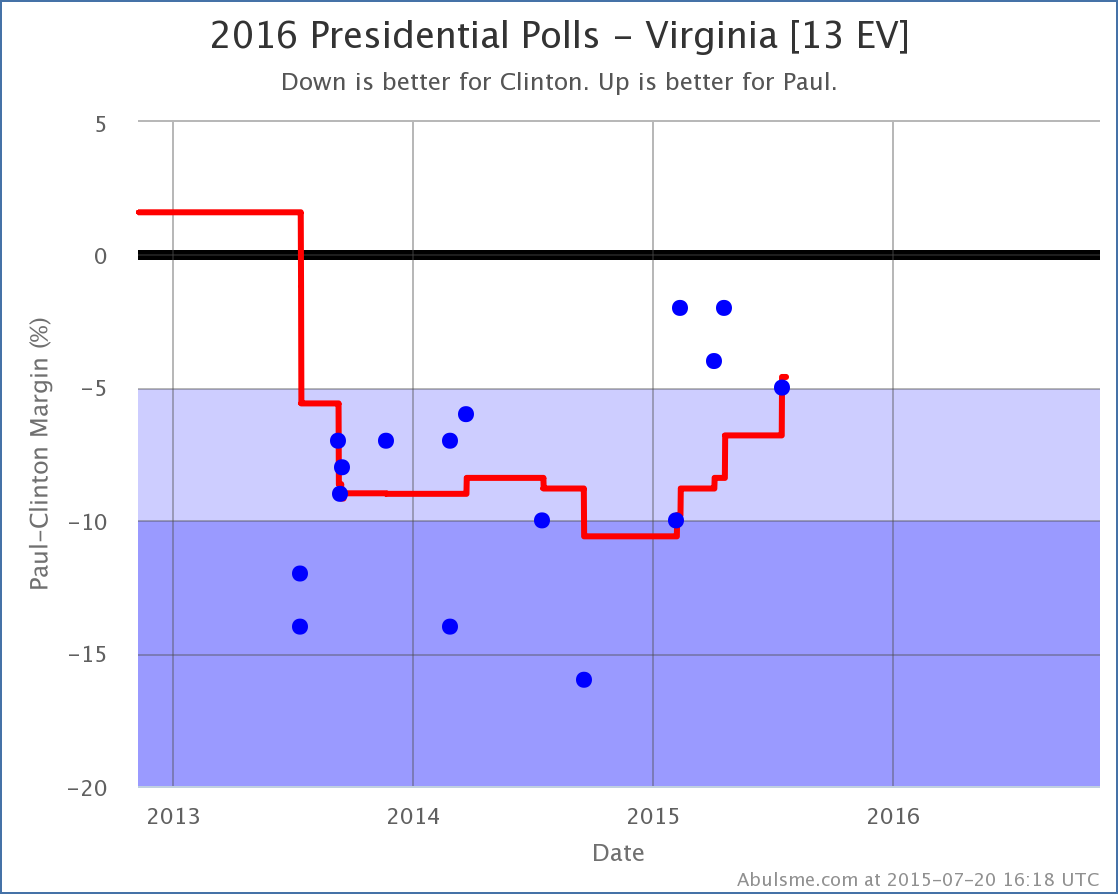
With this latest poll, my average of Clinton vs Paul in Virginia moves to Clinton by 4.6%. While still a substantial Clinton lead, it means Virginia moves to “Weak Clinton” in my average, and I now allow the possibility that Paul could win Virginia. This improves his “best case” where he wins all the states where he leads in the polls, plus all the states where Clinton is ahead by less than 5%.
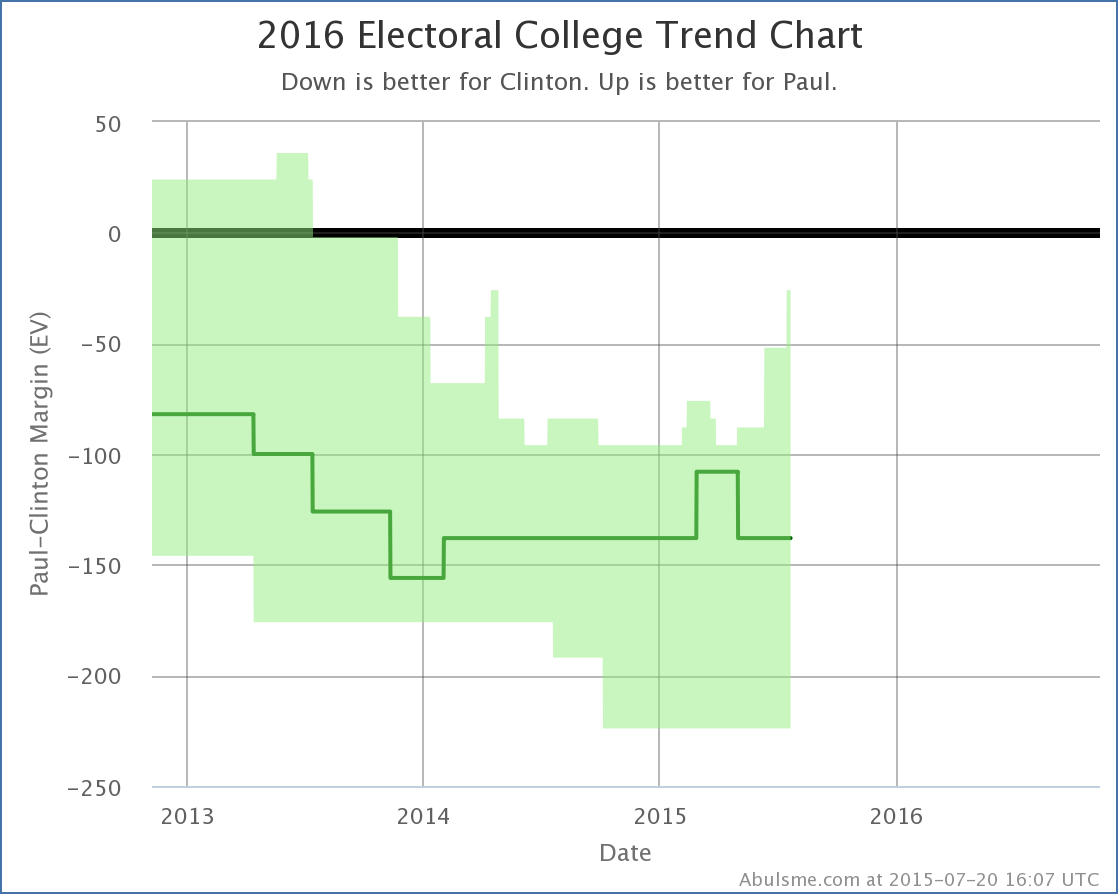
The spike on the upper right is this improvement. Paul’s best case here is still to lose by 26 electoral votes, but this is better than his best case has been since April 2014, and it has been on an upward trend since the beginning of May. So while he isn’t really moving the needle yet on actually bringing more states over to his side of the fence, he is making a few closer, which of course needs to happen first.
The change in Virginia also moved the “tipping point”… basically how far ahead the winning candidate is in the state that would “put them over the edge” in the electoral college. This is a measure of how much polls would have to move nationally, taking into account the structure of the electoral college, in order to flip the election to the other side.
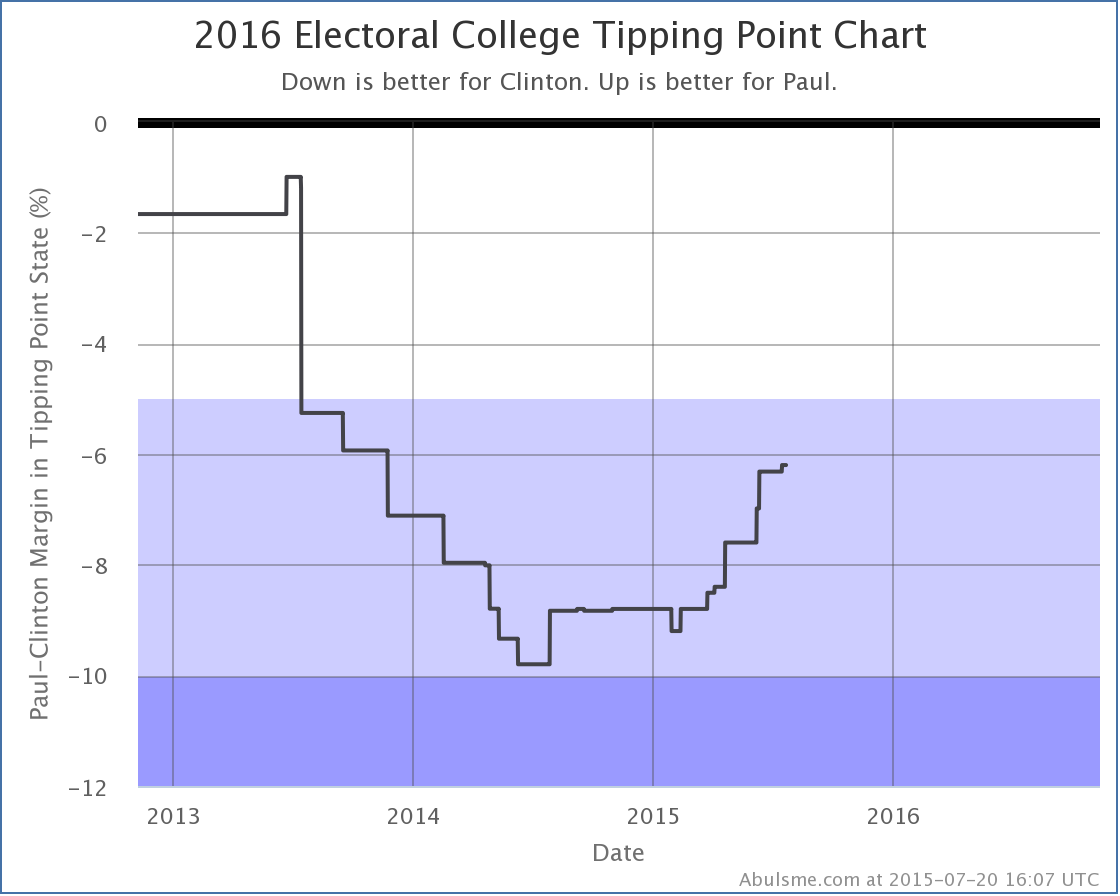
On this metric Paul has had nothing but moves in his direction since February. Slowly but surely his situation has been improving. It of course still has a long way to go. But the trend is there.
Everybody Else
So, we do have to ask the usual question. Is this really Paul getting stronger? Or is this just Clinton getting weaker? So lets look at the comparisons with all of the five best polled candidate combinations.
First Virginia:
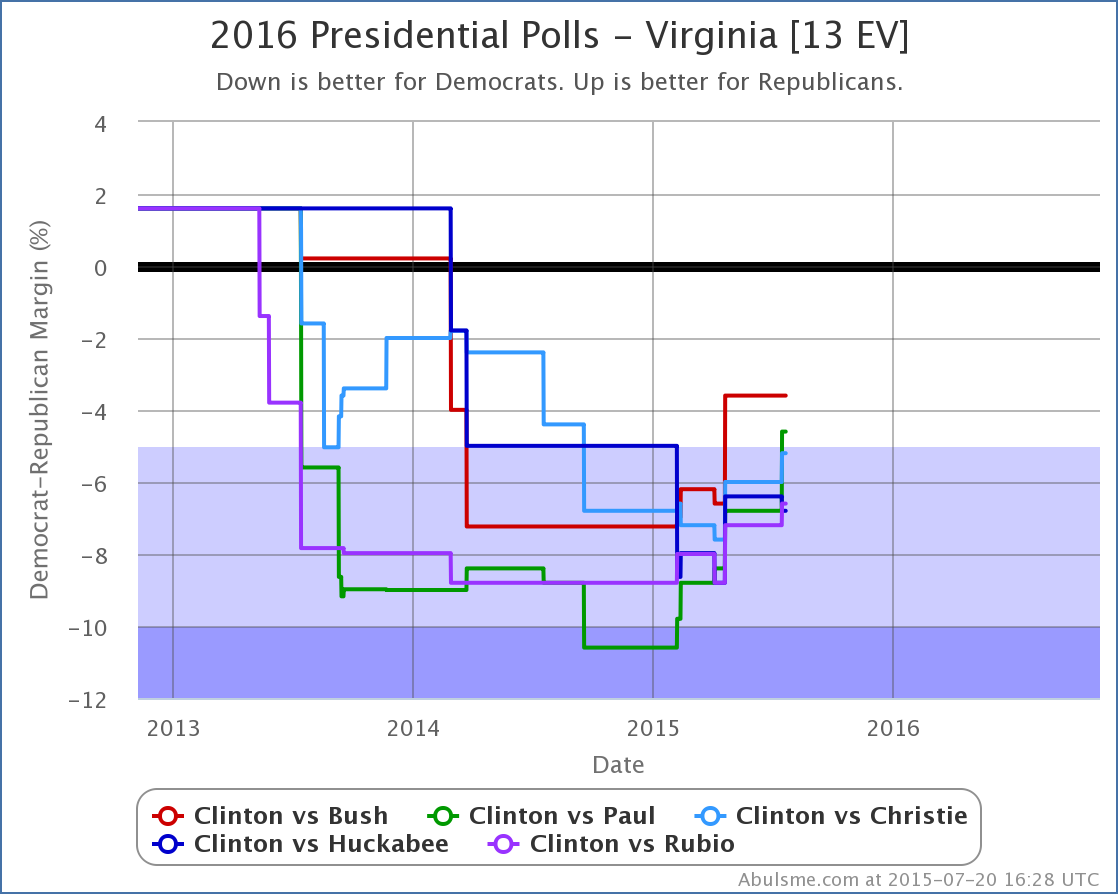
Looking back six months… Bush, Paul, Christie and Rubio have all improved vs Clinton. Only Huckabee has declined in that time frame.
Then the “best cases”:
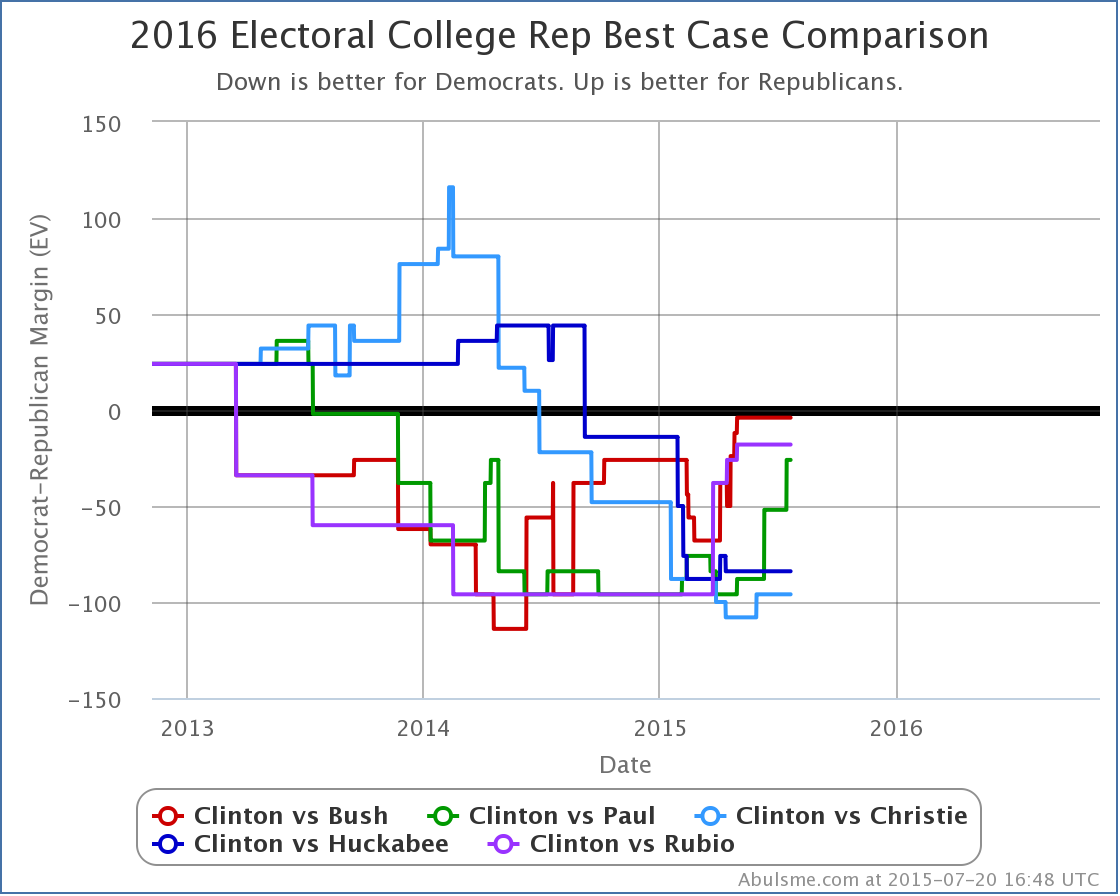
Again looking back six months, this time Bush, Paul and Rubio have all improved, while Christie and Huckabee have declined.
Finally, the tipping points:
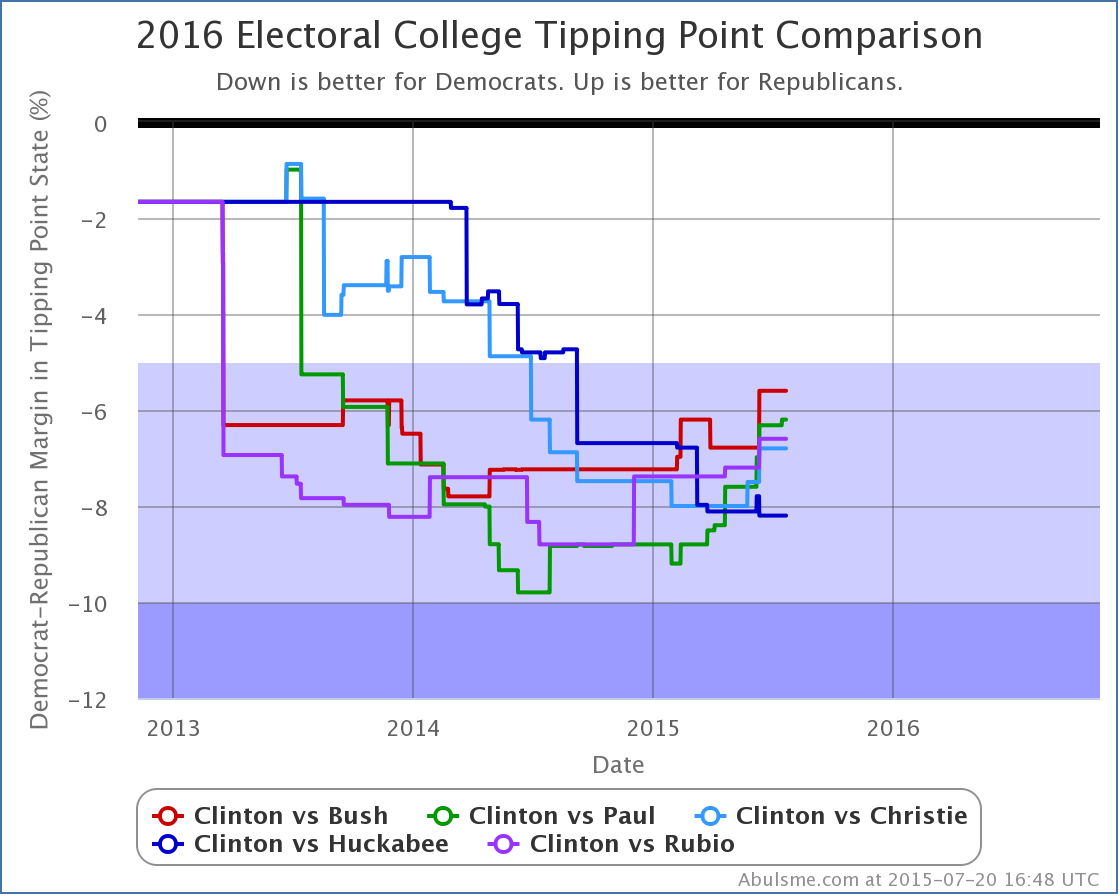
Once again, everybody is gaining on Clinton… except Huckabee. Poor Huckabee.
Anyway, together this means that Clinton seems to be weakening generally against most of the Republican candidates, this isn’t something special for Paul. Today’s update just happened to have him be the one to flip categories today.
Having said that though, if you look at the amount Paul has moved in the three graphs above vs the other four competitors, he’s had the biggest move in Virginia, the biggest move in tipping point, and the second largest move in “best case”. So perhaps there is actually something going on with Paul separate from the more general move against Clinton.
For any of that to matter though, he would still have to win the nomination, which is a long shot. But still…
477.3 days until polls start closing.
Note: This post is an update based on the data on my 2016 Electoral College Analysis Site. All of the charts and graphs seen here are from that site. Graphs, charts and raw data can be found there for the race nationally and in each state for every candidate combination that has been polled at the state level. In addition, comparisons of the best polled candidate combinations both nationally and each in each state are available. All charts above are clickable to go to the current version of the detail page the chart is from, which may contain more up to date information than the snapshots on this page, which were current as of the time of this post. Follow @ElecCollPolls on Twitter for specific poll details as I add them.
Only one change of note this week. PPP did another poll of North Carolina. Of the five best polled candiate pairs… right now still Clinton vs Bush, Paul, Christie, Huckabee, and Rubio… only Clinton vs Huckabee resulted in a category change.
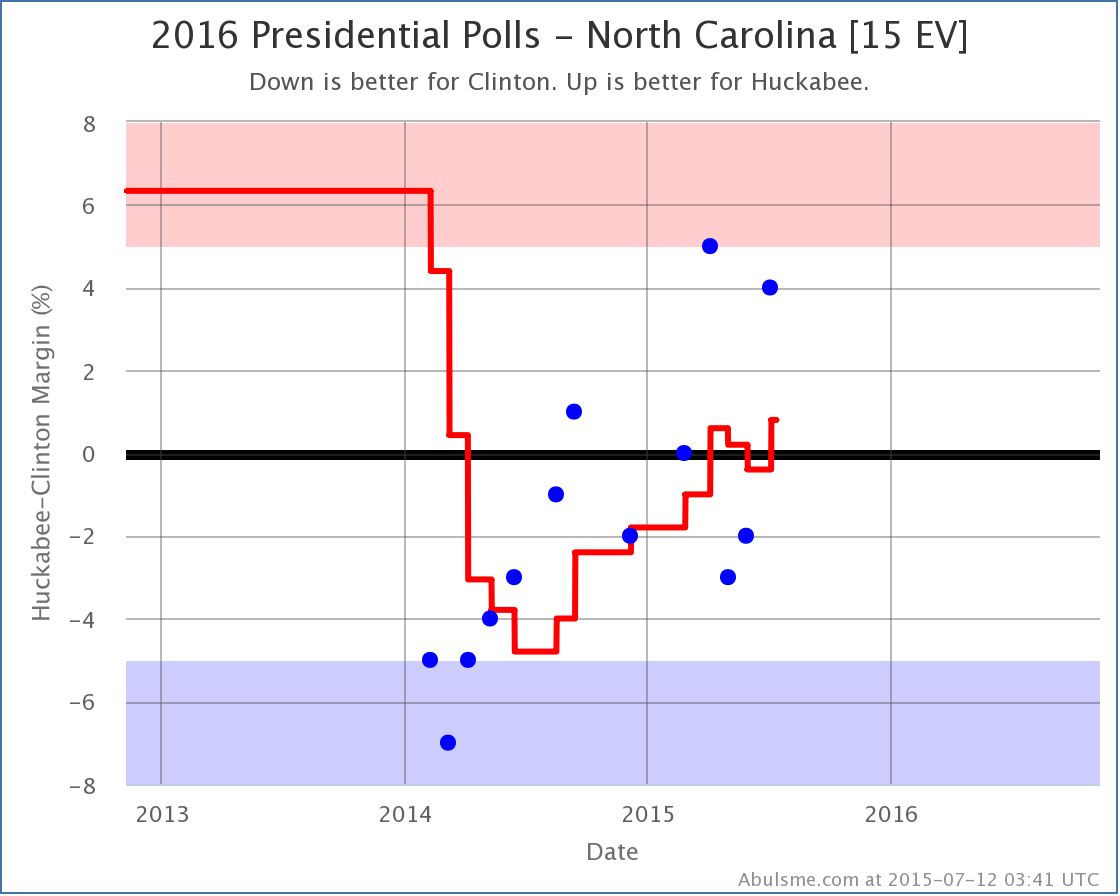
Huckabee takes the lead again after having lost it at the end of May. Looking at the long term trend, Huckabee has been gaining against Clinton in North Carolina for the last year or so. Now, is this just Huckabee, or part of a larger trend against Clinton?
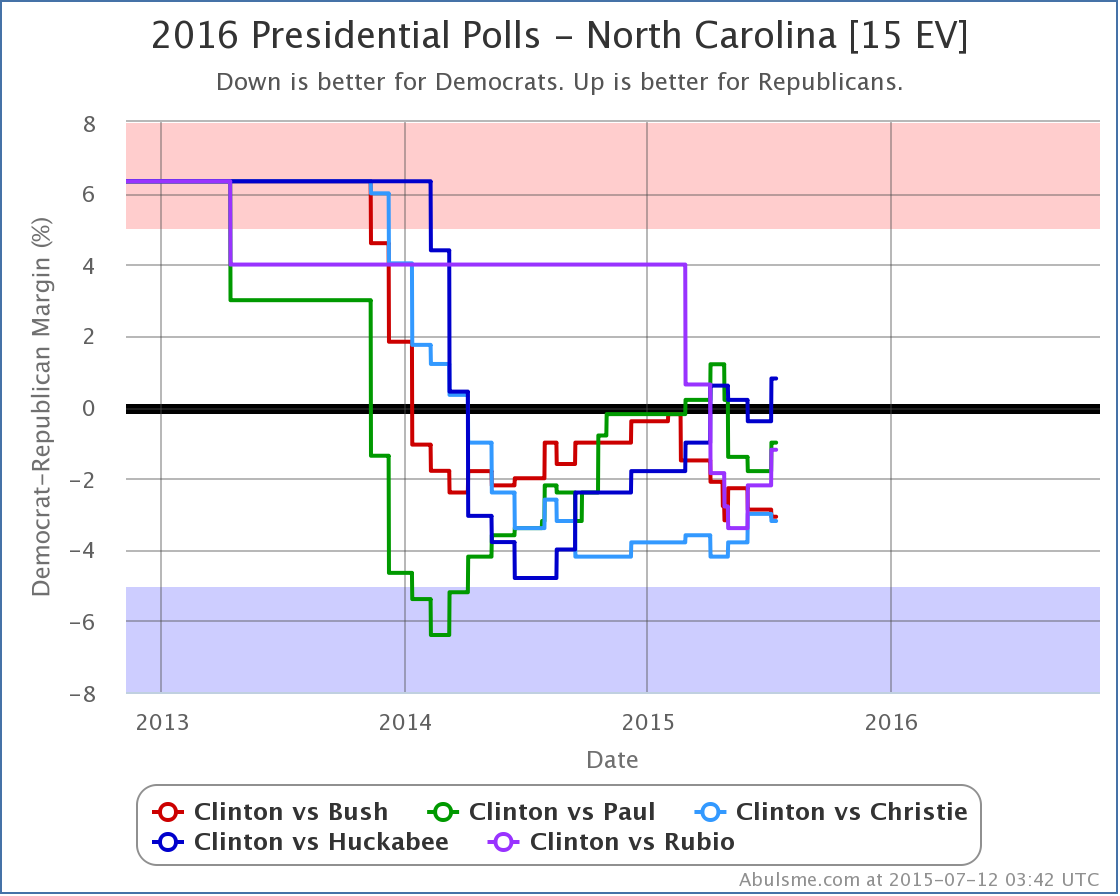
Lets look at how each of these five candidates has done against Clinton in North Carolina over the last six months, namely comparing where they stand today (July 12) vs where they were six months ago (January 12).
- Clinton vs Huckabee: Clinton by 1.8% -> Huckabee by 0.8% (2.6% Huckabee gain)
- Clinton vs Christie: Clinton by 3.8% -> Clinton by 3.2% (0.6% Christie gain)
- Clinton vs Paul: Clinton by 0.2% -> Clinton by 1.0% (0.8% Clinton gain)
- Clinton vs Bush: Clinton by 0.4% -> Clinton by 3.1% (2.7% Clinton gain)
- Clinton vs Rubio: Rubio by 4.0% -> Clinton by 1.2% (5.2% Clinton gain)
So, no. There hasn’t been an across the board Republican gain here, at least not over the last six months. (There is a bit more of move toward the Republicans if you look back a whole year.) Over six months though, we have Huckabee and Christie doing better against Clinton, while Paul and Bush are doing worse.
(You can discount the Rubio results, as six months ago there was only one actual Clinton vs Rubio poll in NC, so this was primarily movement toward the real Rubio numbers away from the average of previous election results, rather than actual movement in Clinton vs Rubio.)
Given this, there might really be something to the notion that Huckabee may be getting some resonance in North Carolina that Bush is not.
Regardless though, North Carolina is “close” for all five of these candidates against Clinton. It could very easily go either way. The differences between these five candidate pairs aren’t actually all that huge. North Carolina is looking like it will definitely be one of the swing states this cycle.
Looking back at Huckabee for a minute, we can see how this changes his “expected” result vs Clinton:
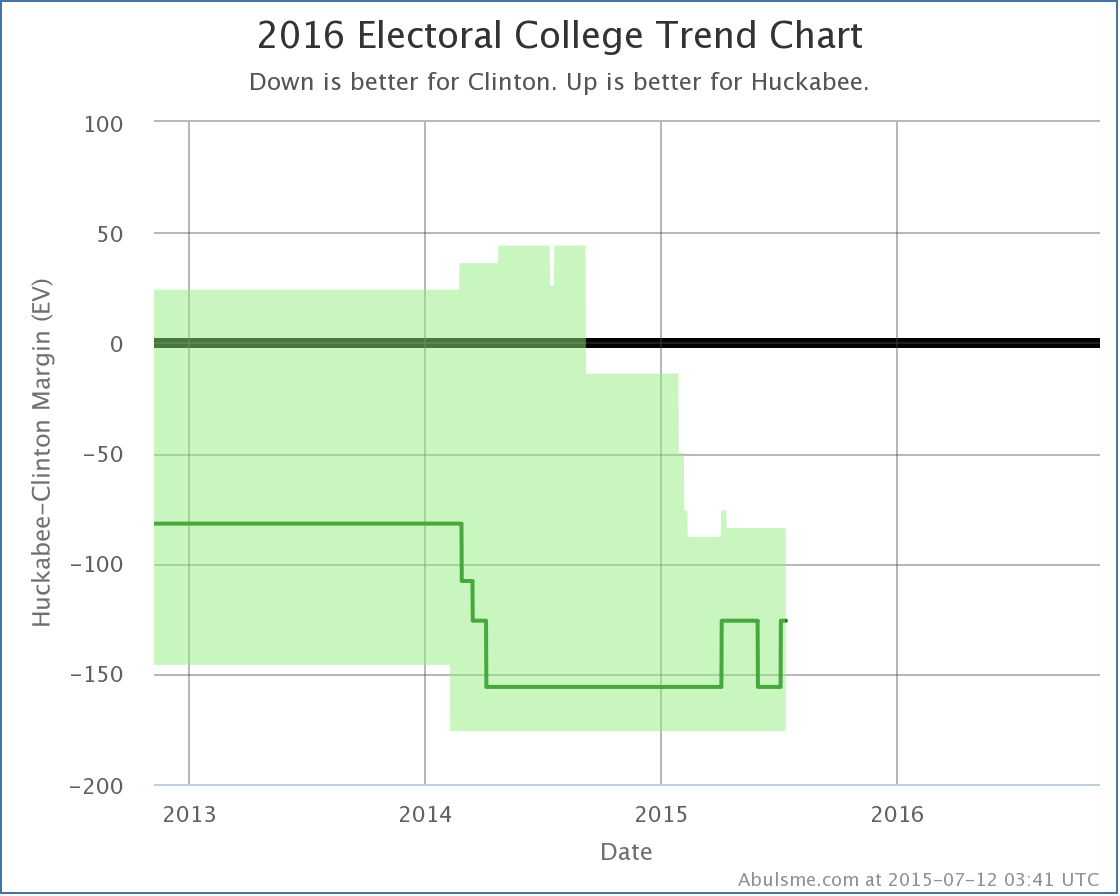
With North Carolina back in his column, if each candidate won every state they are currently ahead in, we end up with… Clinton 332 to Huckabee 206. This is a 126 electoral vote win for Clinton.
This is also an exact match for the 2012 election results, which were Obama 332 to Romney 206. Not only do the numbers match, but every single state matches. So with today’s polls, with Clinton and Huckabee, we essentially end up with an exact rerun of 2012.
Interestingly though, if you look at just the “expected” results such as the above, and not the “best cases” for each of the Republicans (where you give them all the states where Clinton is ahead by less than 5% too) then at the moment, somewhat shockingly I think… Huckabee is actually out performing each of the other four Republicans in the five best polled candidate combinations:
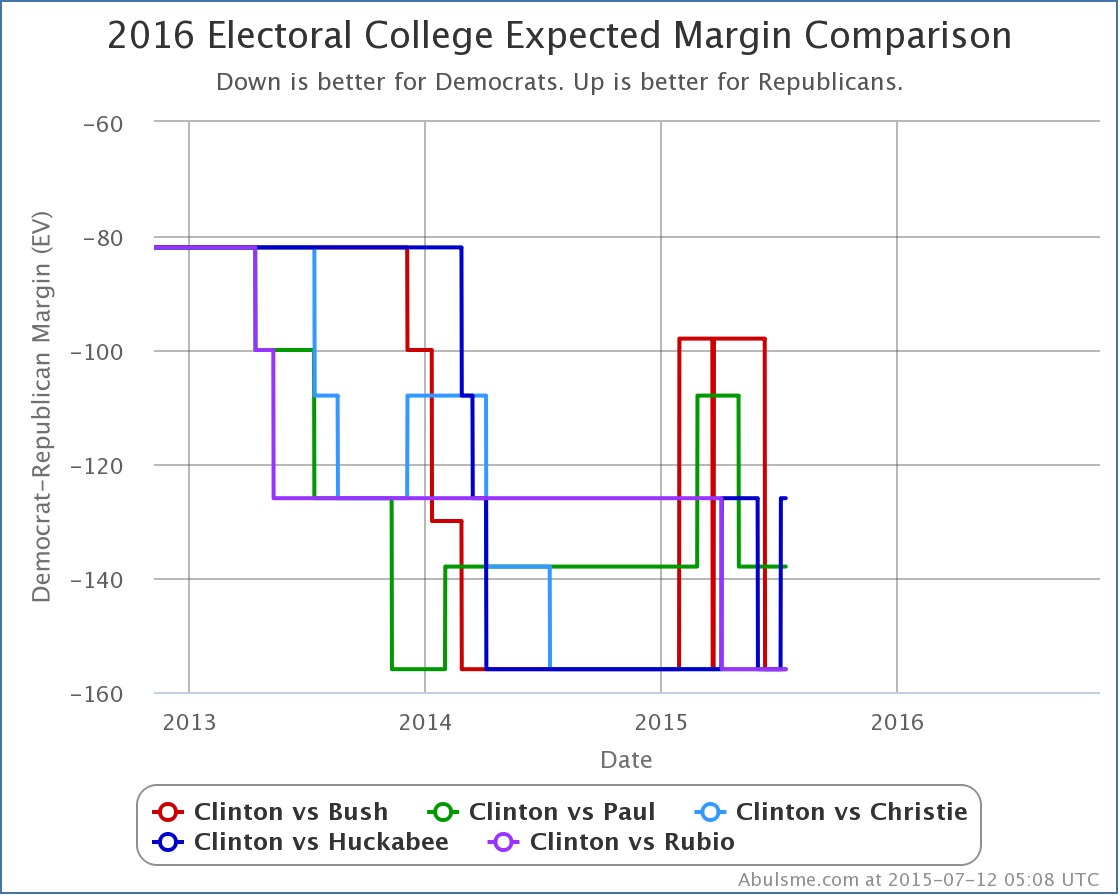
Of the five best polled candidates:
- Clinton vs Huckabee: Huckabee loses by 126 – exact match of 2012
- Clinton vs Paul: Paul loses by 138 – Paul gets all Romney states except NC (15 ev), but gains CO (9 ev)
- Clinton vs Bush, Christie and Rubio: Republican loses by 156 – Republican gets all Romney states except NC (15 ev)
So, with all the polling and back and forth so far and all my various squiggly lines… at least as of today… the only states that are shifted from 2012 for any of these five candidates against Clinton are Colorado and North Carolina. Barely any change at all!
But, as I always try to make sure to mention: All of these numbers are “if the election was held today” numbers, and the election is most certainly not held today! (And there are still many states with little or no 2016 polling yet.)
There will be a lot of events between now and the election, and a lot of campaigning, and a lot more polling. Plenty of time for things to change… potentially a lot.
485.8 days until the first polls close as I post this. Stay tuned!
Note: This post is an update based on the data on my 2016 Electoral College Analysis Site. All of the charts and graphs seen here are from that site. Graphs, charts and raw data can be found there for the race nationally and in each state for every candidate combination that has been polled at the state level. In addition, comparisons of the best polled candidate combinations both nationally and each in each state are available. All charts above are clickable to go to the current version of the detail page the chart is from, which may contain more up to date information than the snapshots on this page, which were current as of the time of this post. Follow @ElecCollPolls on Twitter for specific poll details as I add them.
Today’s update (which included a Detroit News poll in MI and Quinnipiac polls in Florida, Ohio and Pennsylvania) brings seven changes of note to the five best polled candidate pairs. Plus Clinton vs Bush once again takes the top spot as the best polled candidate pair, but there isn’t much else to say about that. As usual, click on any of the charts for more details from election2016.abulsme.com or follow @ElecCollPolls on Twitter for detailed poll information as I add it.
Tipping Point Moves
Five of those seven changes are tipping point changes. (Reminder: The tipping point is the margin in the state that would put the winning candidate “over the top” in the electoral college.) The tipping point changed for all five of the candidate pairs, so instead of looking at them individually, lets look at the comparison:
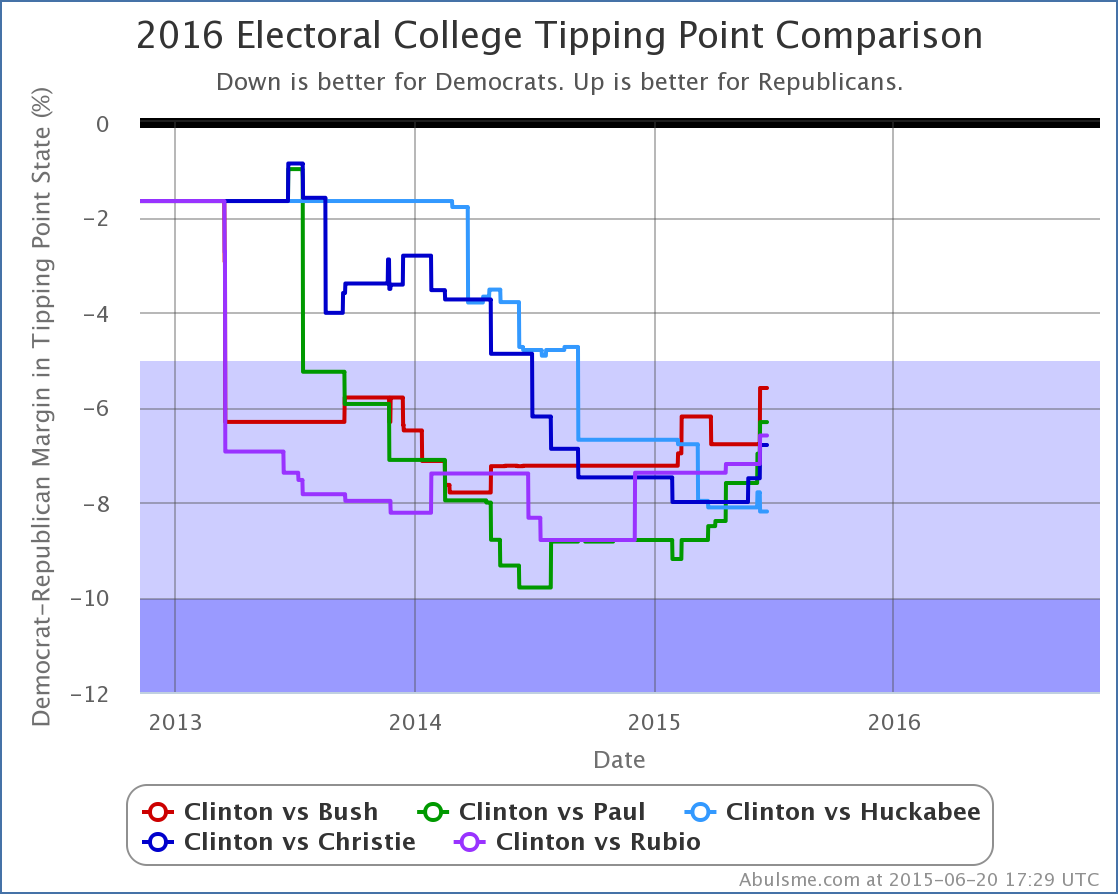
Looking both at the most recent change, and also at the change over the last three months, Bush, Paul, Christie and Rubio have all improved vs Clinton. Only Huckabee’s situation has worsened. For the candidates that are improving, the movement seems to be accelerating.
Bush’s tipping point specifically is down to only 5.6%. This still translates into a “Strong” lead for Clinton according to the categories I have defined, but we’re getting pretty close to the 5.0% boundary. Just a few more good polls for Bush in the right states, and the tipping point could move into the “Weak Clinton” zone, meaning that if Bush managed to win all of the close states (including the ones where Clinton is a little ahead) he would win. At that point, we would have an actual competitive race. Clinton would still be ahead, but a Bush win would be within the realm of reasonable possibility.
Clinton vs Bush
In addition to the tipping point changes, a couple of states changed categories. First up, Bush in Florida.
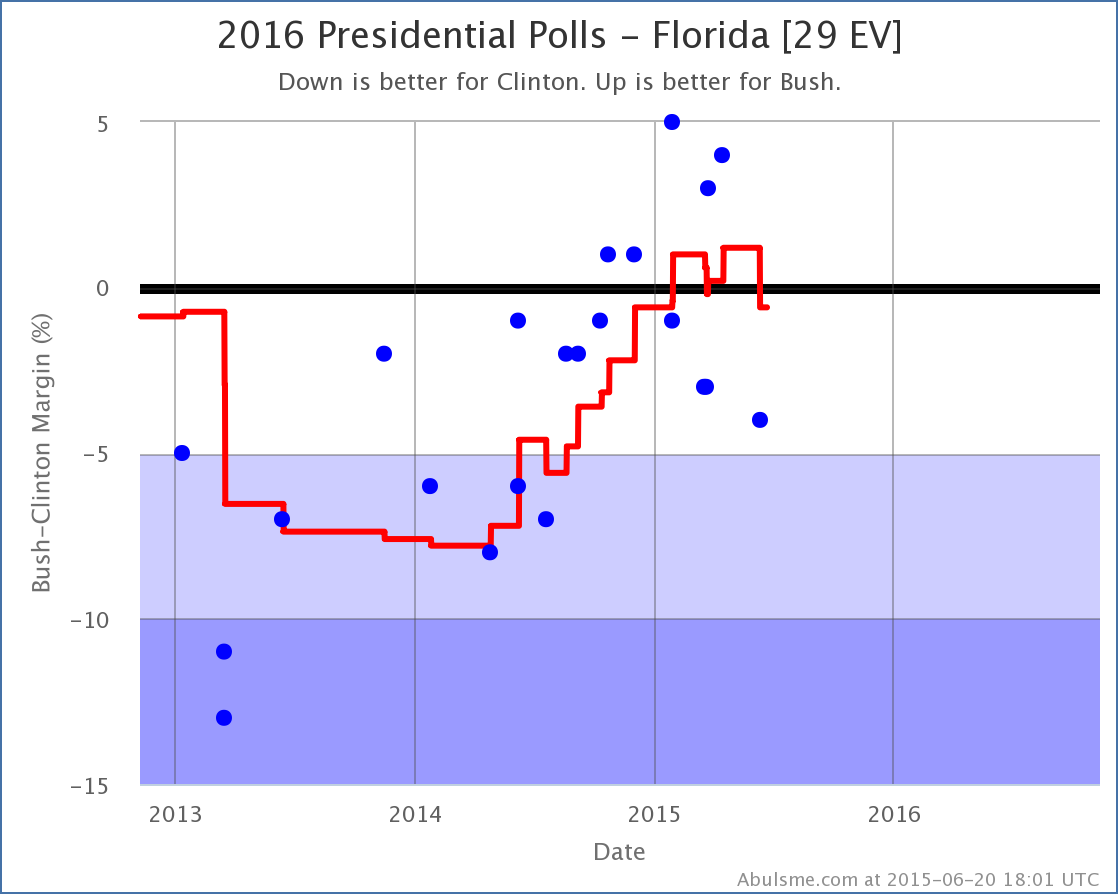
Florida moves from just barely Bush, to just barely Clinton. Bottom line, in this paring, Florida is close. Right now this is true for only Bush and Rubio. The other three Republican candidates in the top five polled pairs trail Clinton badly:
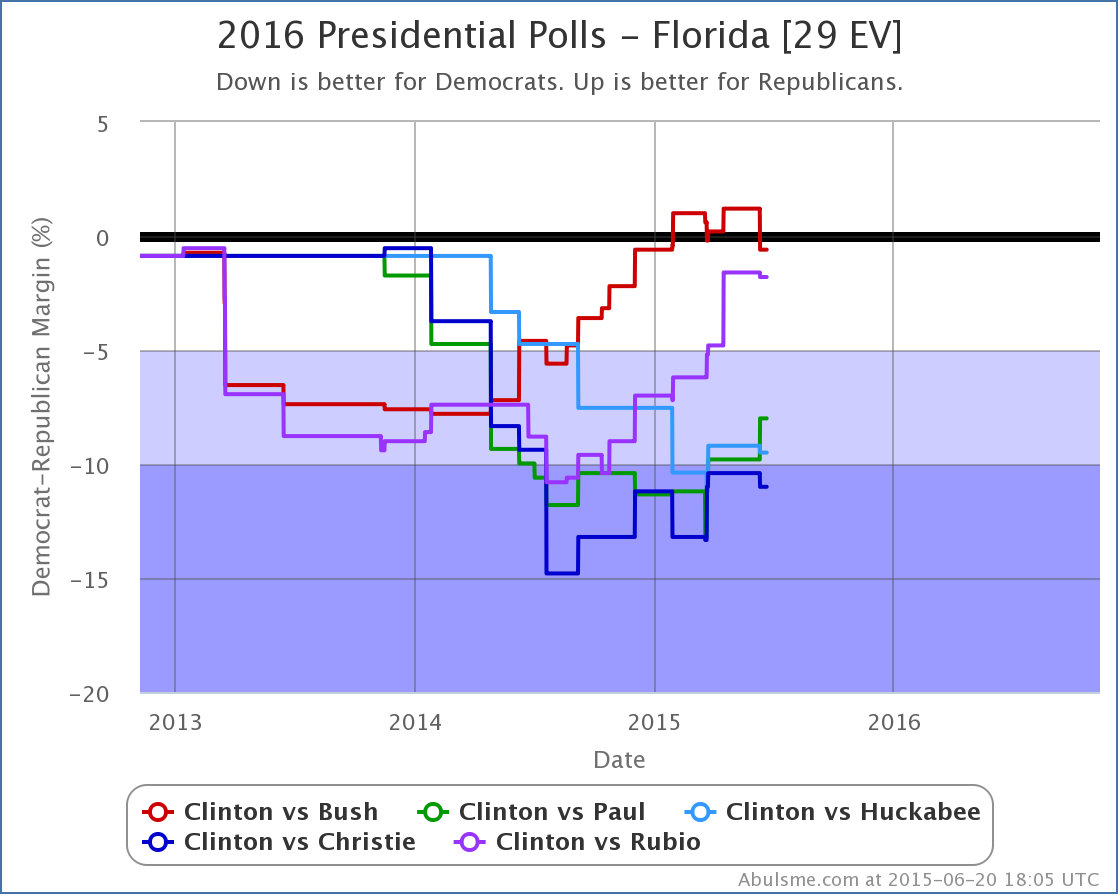
For Bush though, for the moment, Florida slips off the list of states he is ahead in, and his “expected case” drops:
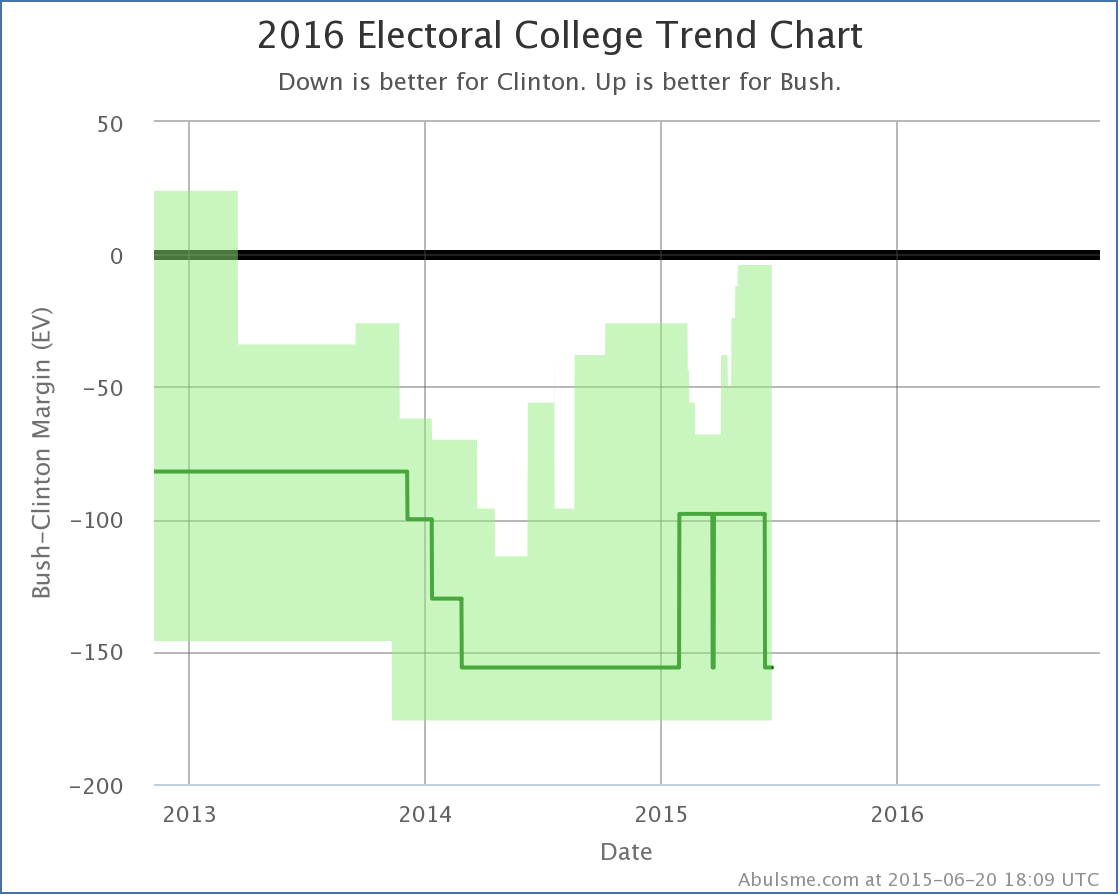
This brings Bush’s “expected” result back to Clinton 347 to Bush 191, a 156 electoral vote loss. (This is the same margin at the moment as Huckabee, Christie and Rubio… only Paul differs right now, losing by only 138 electoral votes because unlike the others, Paul is ahead in Colorado.)
Clinton vs Paul
The other category change is that in Clinton vs Paul, Ohio moves from Strong Clinton to Weak Clinton:
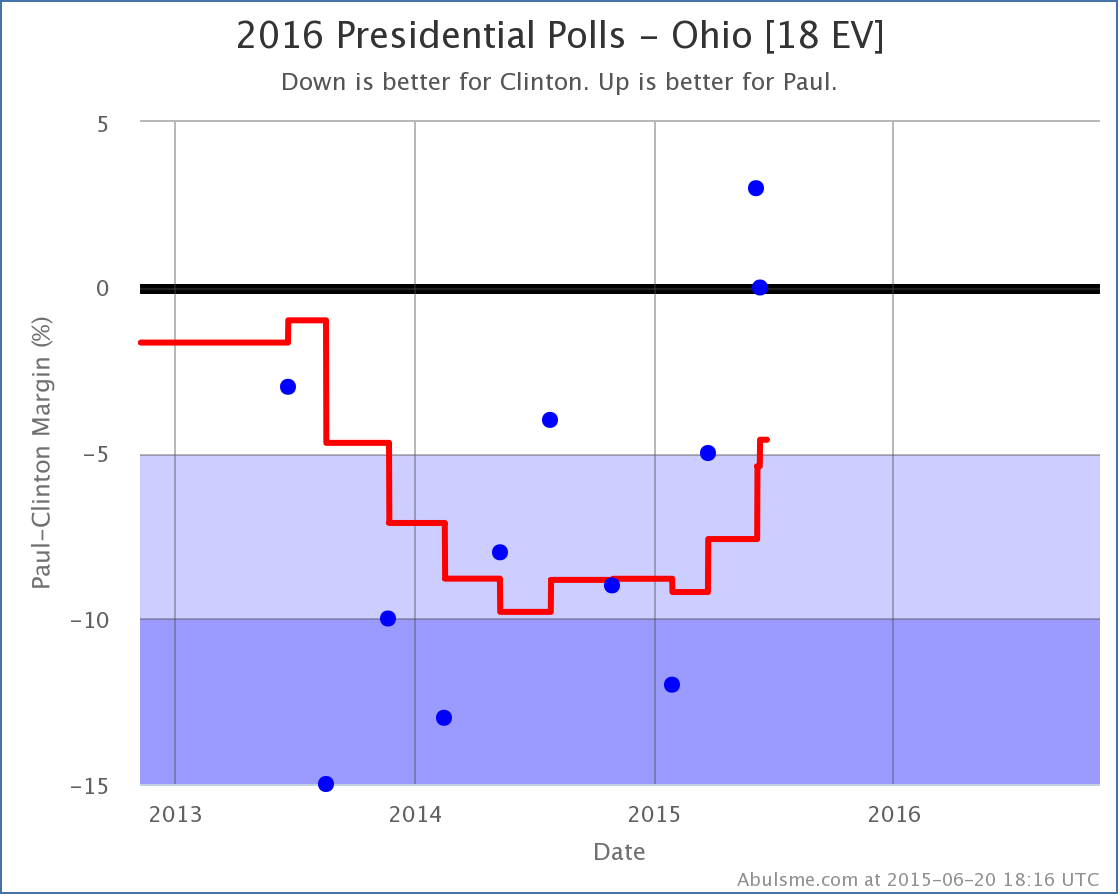
The last two polls actually show Paul ahead in Ohio. The average, which covers almost 8 months of polls at the moment, isn’t there yet, but it is moving in Paul’s direction. Ohio is looking closer and closer.
And that isn’t just Paul. If we do the comparison in Ohio, we see this movement is broader:
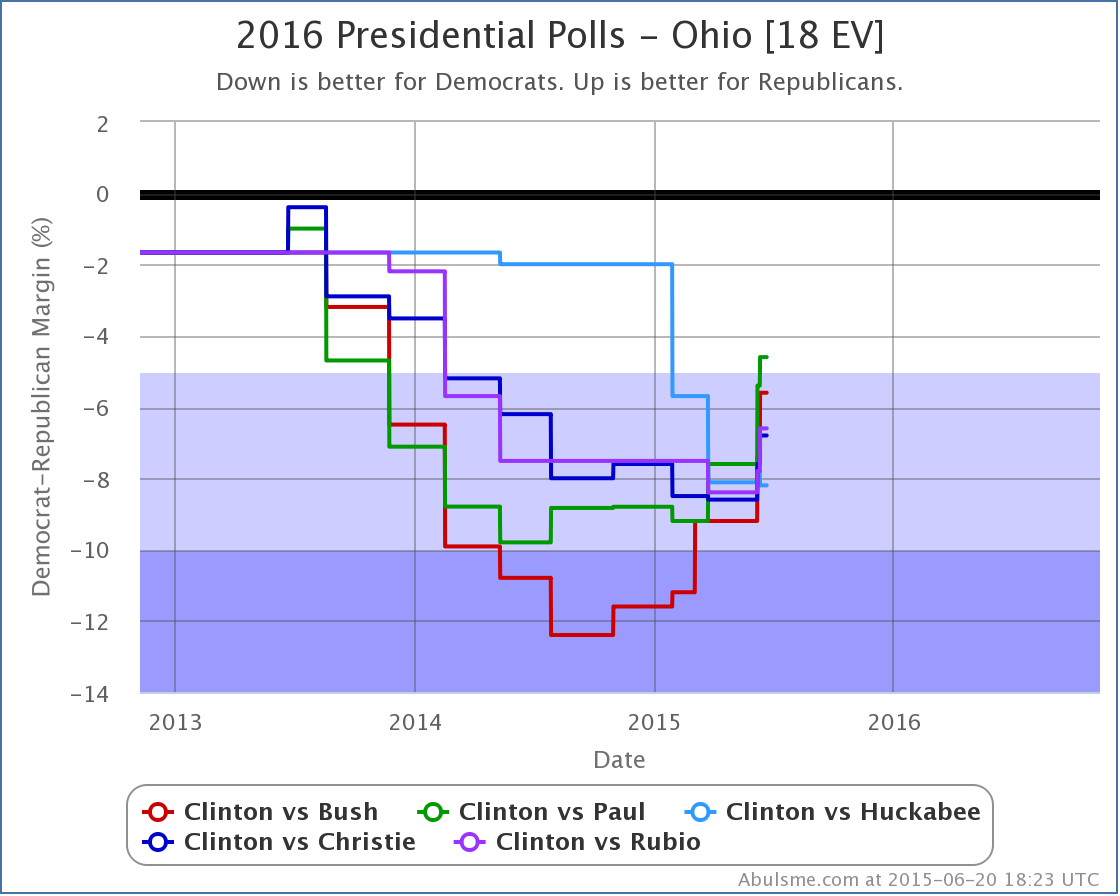
Once again, everybody except Huckabee is improving against Clinton. Or perhaps it would be better to say that Clinton is falling. Either way, Ohio is looking closer than it did. Paul is the first of these five candidates to move Ohio into the “potential win” category according to my classifications, but Bush isn’t far behind.
For Paul, this improves his “best case” where we give him all of the states he is ahead in, plus all the states where Clinton’s lead is less than 5%:
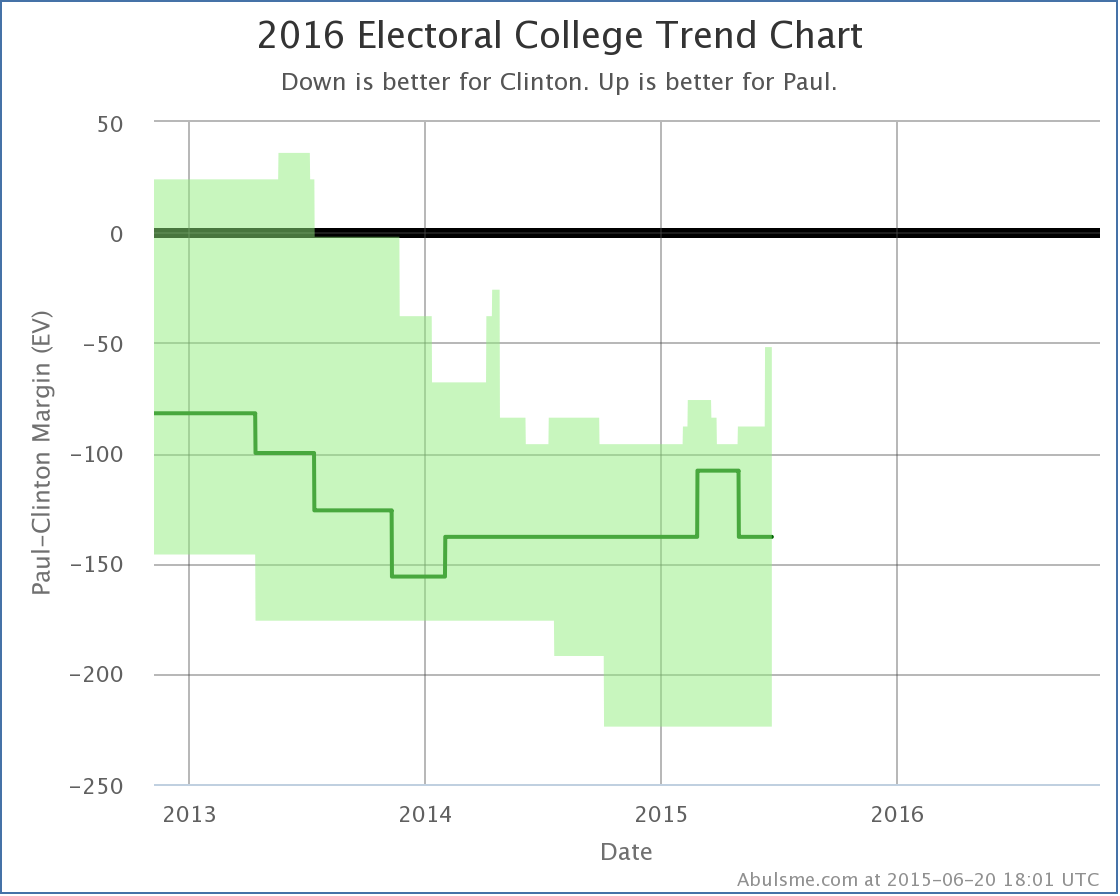
In his “best case” Paul now only loses to Clinton by 52 electoral votes. This is Paul’s best best case since I officially launched this analysis after the November election.
Pennsylvania
The polls this time around in Michigan didn’t change anything, but the ones in Pennsylvania are worth mentioning even though there were no category changes for any of the five candidate pairs.
Brandon Finnigan (@ConArtCritic) of the Ace of Spades HQ Decision Desk election tracking site tweets constantly about how Republicans should be targeting Pennsylvania as the keystone (get it?) to their election strategy. In his recent article “How The GOP Could Win Pennsylvania” he outlines the argument. So lets look at how the state is going given current polling. (Which of course will change a lot before we get to the election.)
Moves in Pennsylvania did contribute to some of the tipping point changes we talked about today, and when we look at Pennsylvania, we are seeing what looks like clear movement toward the Republicans, even though it isn’t quite switching categories yet:
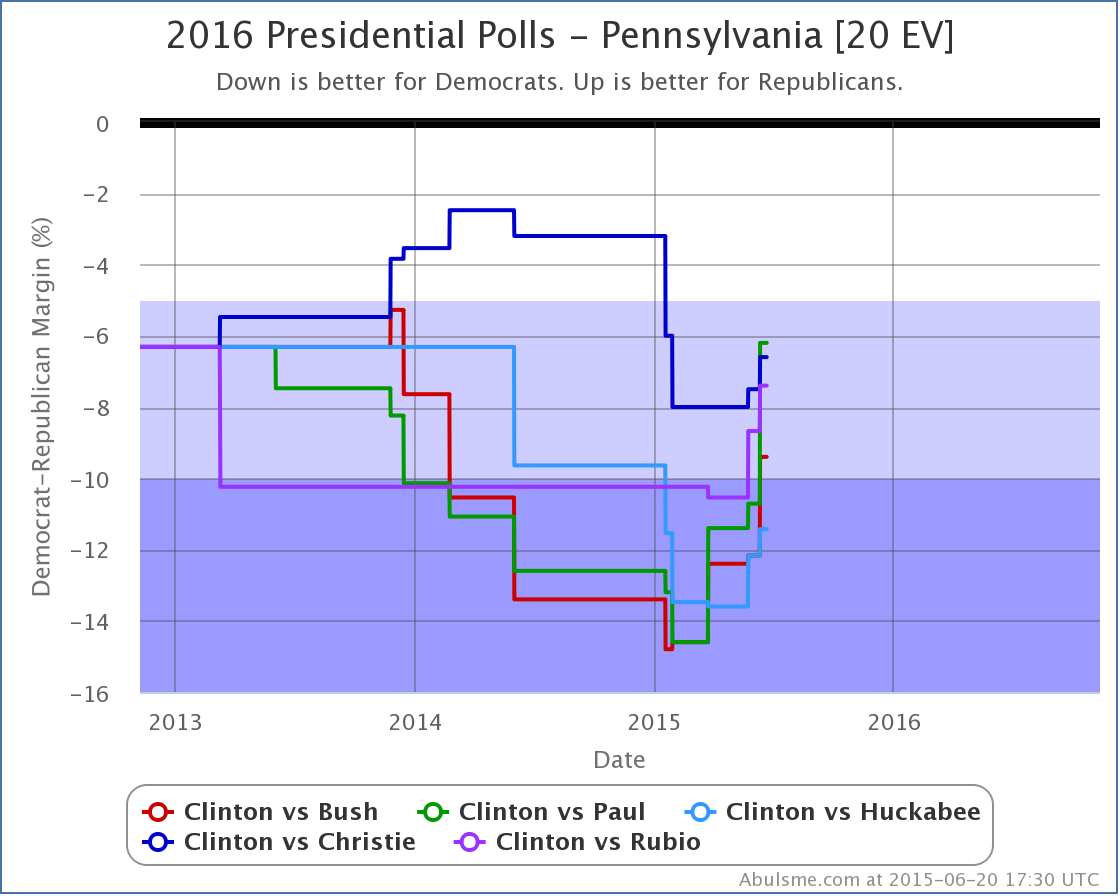
All five candidates have improved against Clinton in the last three months, some of them by large margins. Paul went from down by 14.6% in March, to down by only 6.2% right now. That is a huge move!
Now, this probably isn’t because any of the candidates are specifically targeting Pennsylvania at this point, but more likely just a reflection of Clinton’s overall decline nationally. None of the candidates have made it close in my poll averages yet, but Clinton’s margins have been narrowing rapidly.
Finnigan is certainly right that if the Republicans can make Pennsylvania close, let alone turn it red, this probably means an overall Republican victory in the electoral college, because whatever they did that could flip Pennsylvania would almost certainly flip other blue states that currently are closer than Pennsylvania as well.
Now, does that mean targeting Pennsylvania specifically rather than going after those closer states first is the best strategy? I don’t know.
For Bush for instance, if you start with the states he is already ahead in and then see which states he would need to flip to win, you get this list (in order by how far behind Bush is right now in my poll averages):
At that point Bush would have enough electoral votes to win. To get to Pennsylvania on this list, you’d have to also go past Minnesota, Nevada, Wisconsin, and Michigan. Then Pennsylvania.
Would it be better to concentrate directly on the seven states above? Or is jumping forward to Pennsylvania’s 20 electoral votes somehow an easier path? If Pennsylvania is specifically more vulnerable due to some of the factors Finnigan mentions, then maybe.
I think Finnigan’s point is broader than that though. It isn’t that Pennsylvania is a better target than Ohio or Colorado, although maybe it is. It is more that if the Republicans took Pennsylvania seriously, and did everything they needed to do to win Pennsylvania, then those same things could be applied more broadly, and a lot of other states would move too, and the Republicans would not just win, but win clearly, not a “just barely” sort of win like they got in 2000 and 2004.
The movement we’re seeing so far does show that Pennsylvania is movable. Can it move enough to make it red? I have my doubts absent the Democratic candidate simply collapsing on a nationwide basis. But Pennsylvania might be worth watching anyway…
Bottom Line
Aside from Florida moving her direction but remaining pretty close, and Huckabee generally not doing well, Clinton seems to be continuing to weaken against most Republicans. This reflects the campaign beginning to get under way in earnest, and the name recognition gap slowly diminishing. The question is where this trend ends. After a few debates happen, do we reach some sort of steady state Clinton lead a bit narrower than it is today, or do the Republicans continue to gain on her until we really have a race that could go either way, or even with Republicans in the lead?
As usual, stay tuned. 507 days to go!
Note: This post is an update based on the data on my 2016 Electoral College Analysis Site. All of the charts and graphs seen here are from that site. Graphs, charts and raw data can be found there for the race nationally and in each state for every candidate combination that has been polled at the state level. In addition, comparisons of the best polled candidate combinations both nationally and each in each state are available. All charts above are clickable to go to the current version of the detail page the chart is from, which may contain more up to date information than the snapshots on this page, which were current as of the time of this post. Follow @ElecCollPolls on Twitter for specific poll details as I add them.
Edit 23:07 UTC to add some additional links to the election site and Twitter.
This last week brought a new set of Ohio results from PPP. With this poll Clinton lost significant ground against basically all opponents in the averages. Concentrating as we usually do on the five best polled candidate combinations, this is what we see:
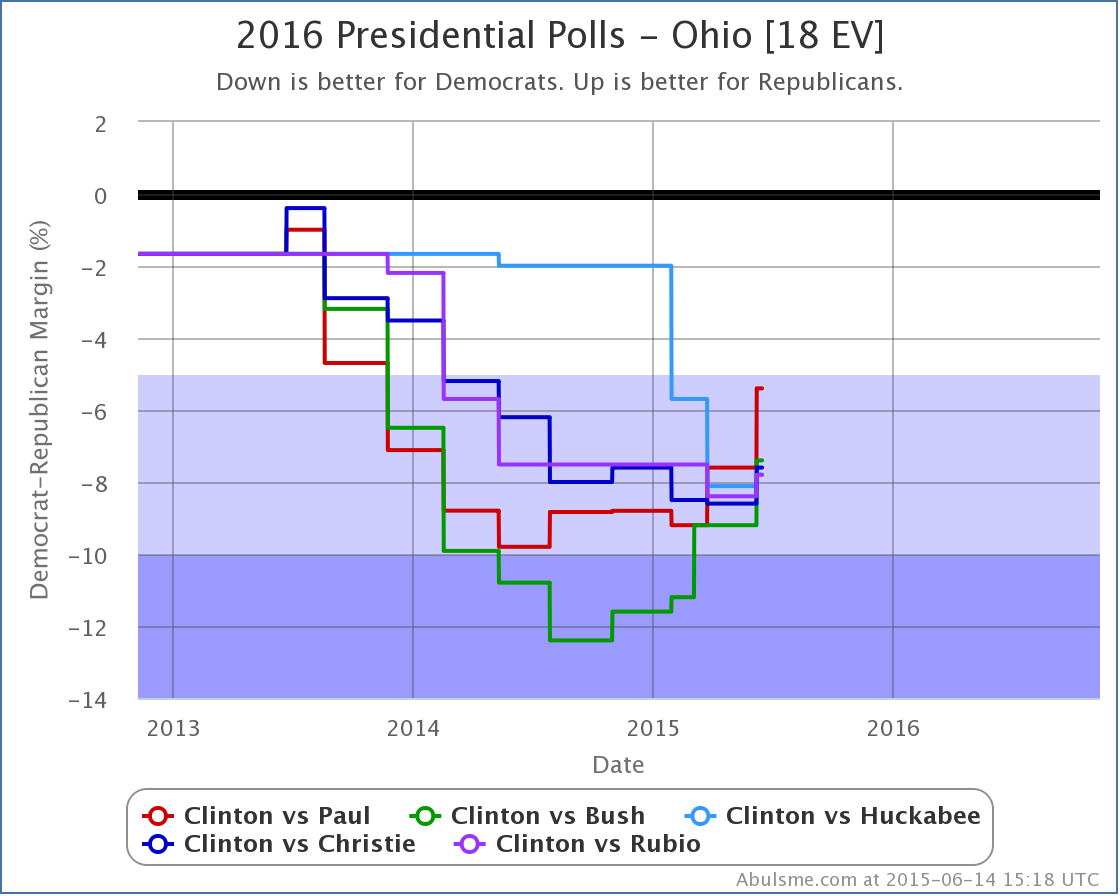
All five of these candidates improved against Clinton based on this latest poll. Looking back a little and comparing now with three months ago, we see that Paul, Bush and Christie have improved their positions, while Rubio and Huckabee have fallen further behind. Of these, Paul has moved the most, from down by 9.2% in March, to only down by 5.4% now, a gain of 3.8%. Paul now does the best of these five candidates against Clinton in Ohio.
Ohio is not a good place for Clinton to be losing ground. Ohio’s 18 electoral votes can make a huge difference. Many paths for Republican victory require Ohio. And the losses here are quite possibly indicative of similar slippage in other states that haven’t been polled enough lately to see it yet. This is not a happy trend for Team Clinton.
Lets switch to looking nationally. Do we see loss of ground there too?
These changes in the Ohio average directly change the tipping point for two of the five candidates, Paul and Huckabee. Paul moves from being down by 7.6% with the tipping point in Ohio, to only being down 7.0% in Minnesota. Meanwhile Huckabee moves from being down 8.1% with the tipping point in Ohio, to being down 7.8%, with his tipping point still in Ohio.
But lets look again at all five candidates against Clinton over not just this change, but the last few months:
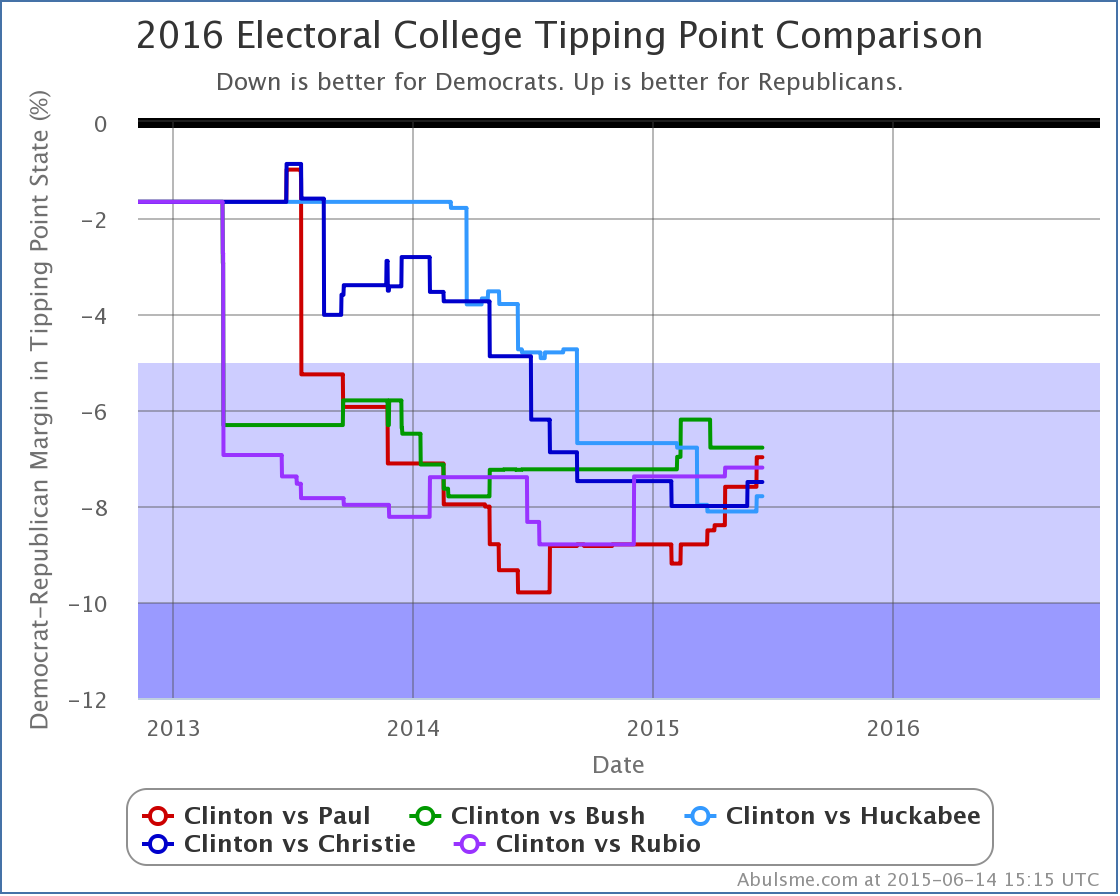
Once again lets compare now to three months ago. Remember, the tipping point essentially represents how much national public opinion needs to move to flip the electoral college result. Paul, Huckabee, Christie and Rubio have all improved since March. Only Bush has declined in that timeframe. (Bush is still better than he was six months ago though.)
Also once again, Paul has improved the most against Clinton during that the last three months, going from down 8.8%, to only down 7.0%.
And yes, yes, all five of these candidates are still way behind. But the overall movement seems to be in the Republican’s favor at the moment. If these trends continue, before too long we may have an actual race on our hands instead of a Clinton blowout!
As I noted in the latest Curmudgeon’s Corner podcast, the real media bias is toward having an exciting race, and while I’m not “the media” I am not immune to this bias… a closer race is a more fun race to watch… so I’ll always be rooting for whoever is behind. :-)
Seriously though, when I posted my first analysis of the 2016 race on this site in November, I mentioned that we should expect tightening, and that Clinton would most likely never again look as good as she did then. The general public had barely heard of most of the non-Clinton candidates, she had come off her Secretary of State stint with fairly high approval ratings, and the campaign against her had yet to start in earnest… and she had been keeping quiet, so fewer opportunities for her to make mistakes too.
As things get in to gear, all of those things change. We’ve just seen the very beginnings of this, and already there is a visible impact in Clinton’s lead. Her lead is still a healthy one, but we’re definitely seeing the signs of the battle starting to be engaged.
513 days to go.
Note: This post is an update based on the data on my 2016 Electoral College Analysis Site. All of the charts and graphs seen here are from that site. Graphs, charts and raw data can be found there for the race nationally and in each state for every candidate combination that has been polled at the state level. In addition, comparisons of the best polled candidate combinations both nationally and each in each state are available. All charts above are clickable to go to the current version of the detail page the chart is from, which may contain more up to date information than the snapshots on this page, which were current as of the time of this post.
I added some recent results from PPP in Pennsylvania today. PPP polled 13 candidate combinations. Of these only one resulted in a change worth noting in one of our top five best polled candidate combinations. (I consider it a change worth noting if the expected electoral result changes, or the “best case” of one of the two candidates changes, or the tipping point changes.)
Clinton vs Christie
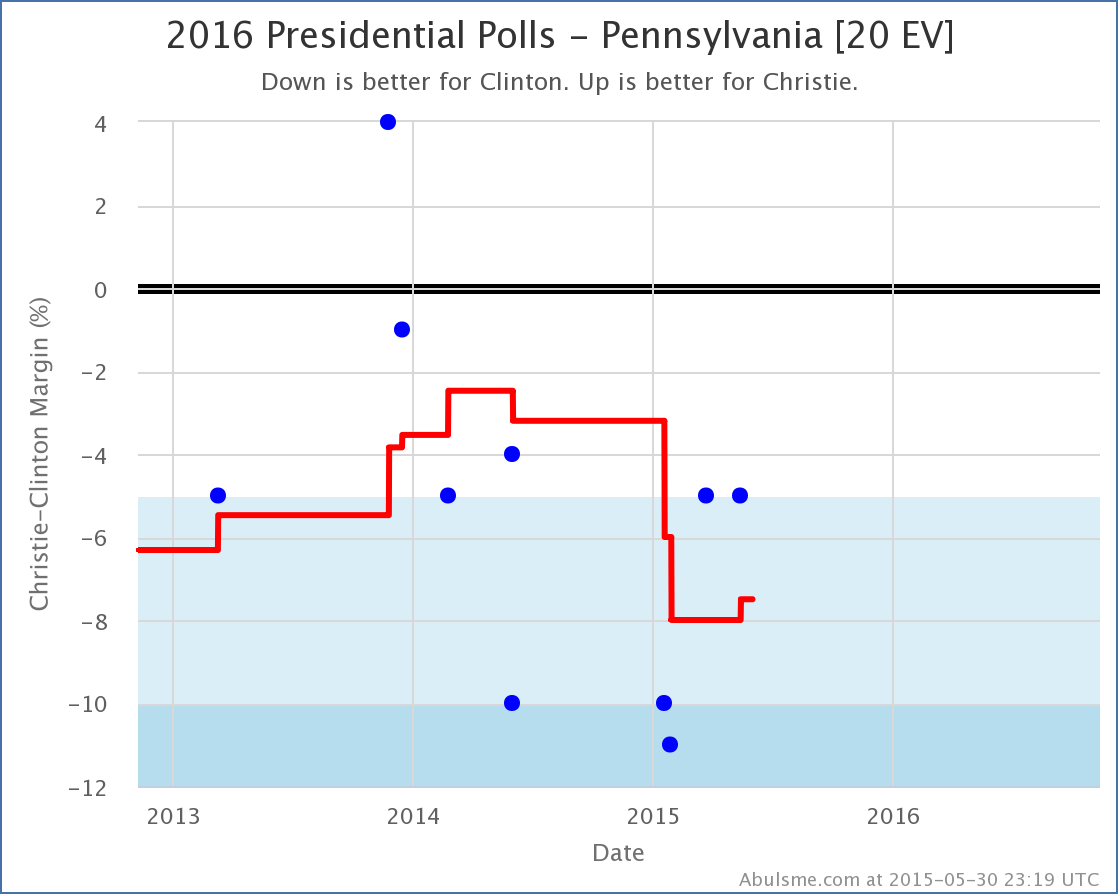
The polling average (which actually contains 6 polls right now rather than the usual five since there is a tie for fifth oldest poll by middate) still shows Clinton with a “Strong” lead, but slightly less of a lead than before. The state doesn’t change categories though, it isn’t close to a “Weak Clinton” state. But it turns out that in Clinton vs Christie, Pennsylvania was the tipping point state, so the topping point changes.
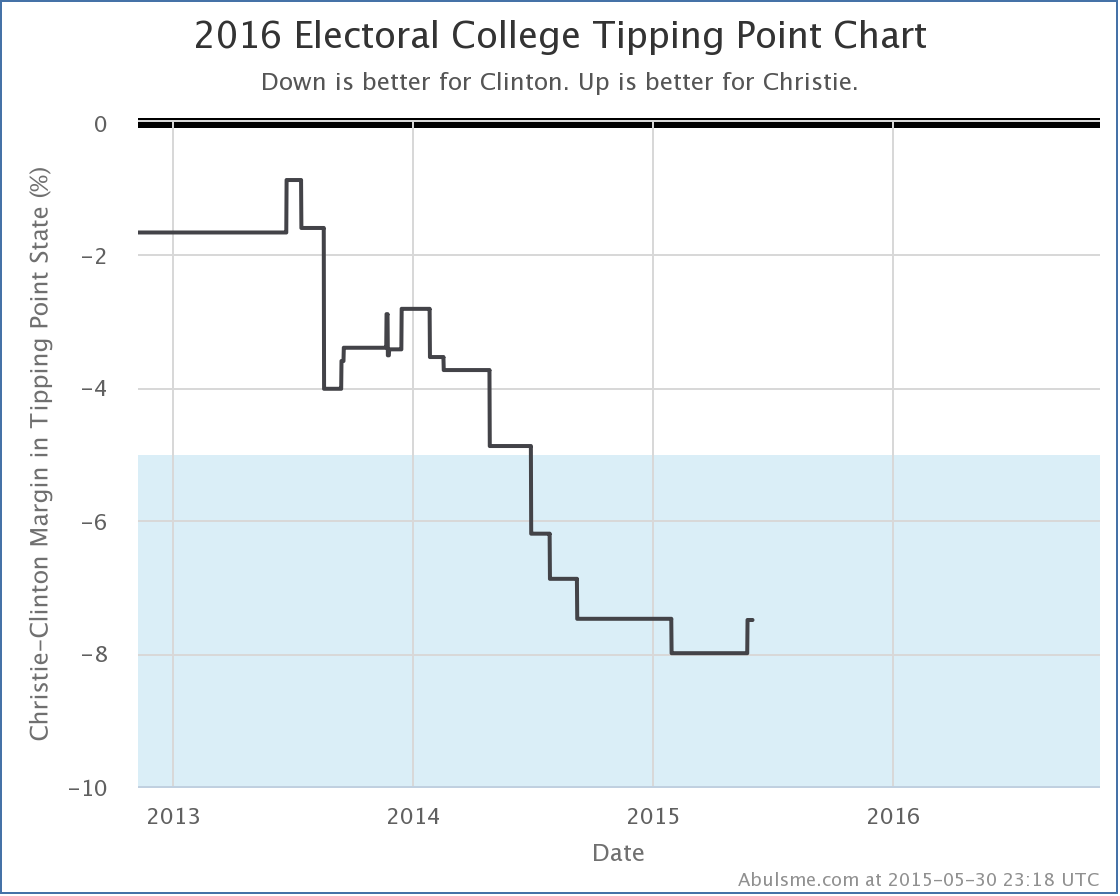
For those who don’t remember, the tipping point is determined by sorting the states by the support level of the candidates, and then seeing which state is the one that would put the winning candidate over the edge. By then looking at the margin in that state, you see how far ahead polls would have to swing on a national basis to change the outcome of the election. In other words, this is a bit like looking at national popular vote numbers, but taking into account the structure of the electoral college. More than most of the other numbers I look at, this represents how far ahead (or behind) a candidate is.
In this case, the tipping point was Pennsylvania, where Clinton was ahead by 8.0%. With the new poll added, the tipping point is still Pennsylvania, but Clinton’s lead is down to 7.5%.
This is the first improvement for Christie in ANY of the metrics I track for Clinton vs Christie since February of last year. Is this the sign of a resurgence for Christie? I kind of doubt it. That ship may have sailed. But it may represent him getting to the point where he won’t get any lower.
The Others
It is worth looking at how some of the other candidates are doing in Pennsylvania though. Here are the Pennsylvania trends for the five best polled candidate combinations at the moment:
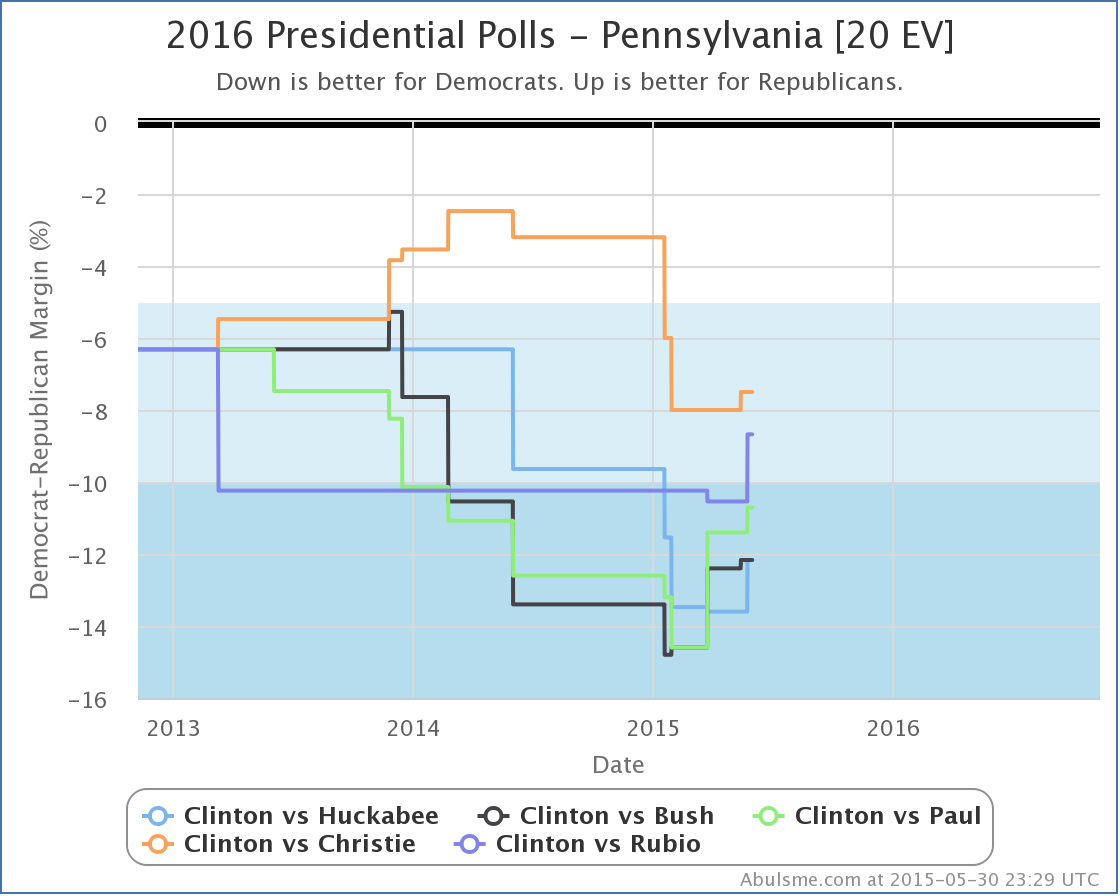
With Christie now enjoying an upward tick of his own, all five Republicans have been improving in Pennsylvania in the last month or so. Bush, Paul and Rubio are all better off than they were at the November elections as well. (Huckabee and Christie are still down from where they were at that point despite the bump in the last month.)
Some of the most recent individual polls in Pennsylvania actually have the state close for some of these candidates against Clinton, but the average isn’t there yet. It is showing movement though. So it is certainly possible we will see further polls confirm Pennsylvania getting closer. Pennsylvania is a big state (20 electoral votes). If Pennsylvania is in play, it opens up a lot more possibilities for the Republicans. So keep an eye on the polls here.
Note: This post is an update based on the data on my 2016 Electoral College Analysis Site. All of the charts and graphs seen here are from that site. Graphs, charts and raw data can be found there for the race nationally and in each state for every candidate combination that has been polled at the state level. In addition, comparisons of the best polled candidate combinations both nationally and each in each state are available. All charts above are clickable to go to the current version of the detail page the chart is from, which may contain more up to date information than the snapshots on this page, which were current as of the time of this post.
Today there was yet another poll in New Hampshire, this time from WMUR, as well as one in New Jersey from Monmouth.
Today’s changes actually lead to Clinton vs Walker bumping Clinton vs Rubio off my “five best polled candidate combinations” list, at least according to my metric.
Even though Clinton vs Rubio isn’t in the top five any more, since it WAS in the top five prior to this update, I’ll briefly cover the change.
Just like Bush and Paul improved their situation in New Hampshire polling yesterday, today’s poll data boosts Rubio in New Hampshire, and Clinton’s lead falls to less than 5%.

Notice the huge range here. Just within the last month, polls have ranged from Clinton up by 12% to Rubio up by 5%. That is a crazy range. I don’t feel a lot of confidence about what is really going on in New Hampshire. The average at the moment though puts New Hampshire in the “Weak Clinton” category vs Rubio, so Rubio’s best case improves:

This doesn’t put Rubio quite as close as Bush, but still puts his best case at losing to Clinton by only 18 electoral votes. So there are a couple of the Republicans now threatening to actually make a race out of this.
Note: This post is an update based on the data on my 2016 Electoral College Analysis Site. All of the charts and graphs seen here are from that site. Graphs, charts and raw data can be found there for the race nationally and in each state for every candidate combination that has been polled at the state level. In addition, comparisons of the best polled candidate combinations both nationally and each in each state are available. All charts above are clickable to go to the current version of the detail page the chart is from, which may contain more up to date information than the snapshots on this page, which were current as of the time of this post.
Just a new batch of PPP polls in Iowa today. Two changes worthy of note:
Clinton vs Bush
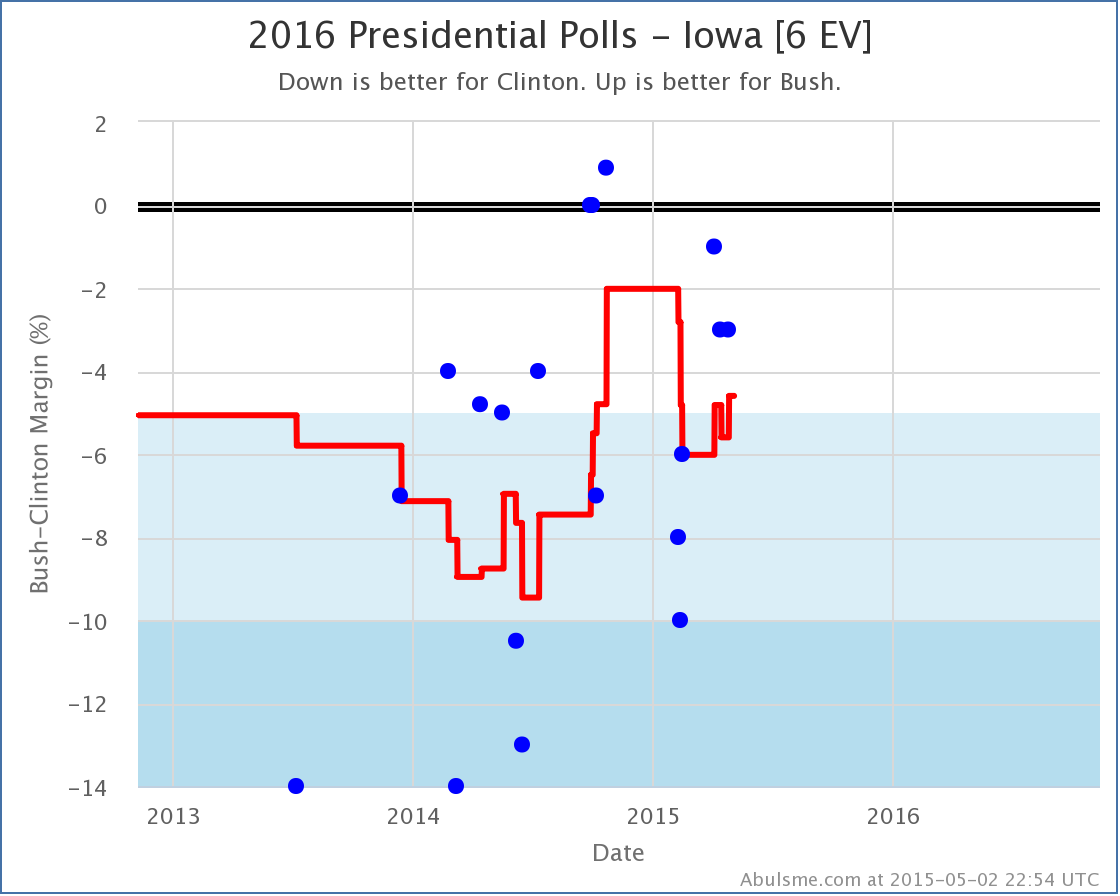
Bush vs Clinton has been bopping up and down across the Clinton leads by 5% line. The average is now once again on the “Weak Clinton” side of this line… and the trend in the last few months seems to be in that direction. With this, we mark Iowa as “possible” for Bush and include it in his best case:
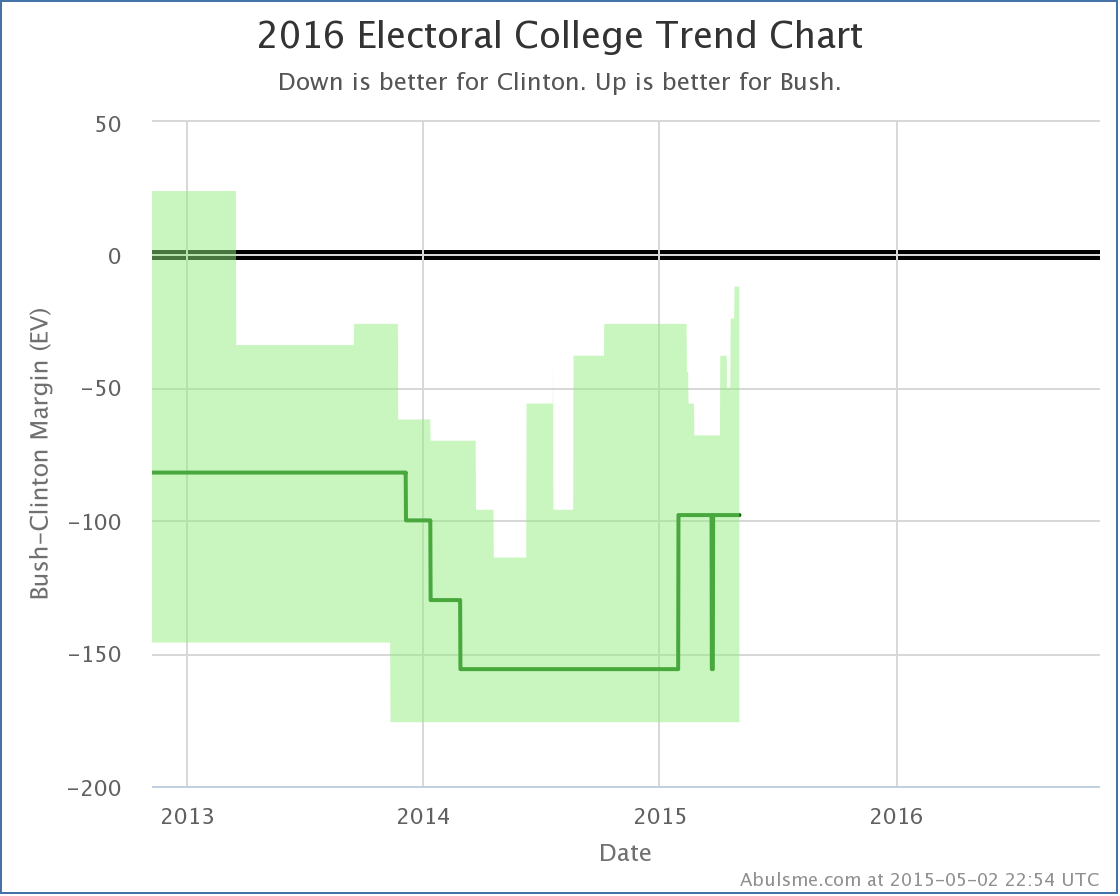
Why look there at that little peak stretching out over the past few weeks. This means that Bush’s best case is now to only lose by 12 electoral votes to Clinton. Bush only needs to get 6 more electoral votes worth of states to move into the “Weak Clinton” category to make his best case actually be to WIN. The best candidate right now is Minnesota (10 EV) where Clinton is ahead by 6.8%. (Minnesota also has only one Bush vs Clinton poll so far, and it was from October, so some new polling there is definitely needed… it may actually already be close, we just don’t have the polling to see it yet.)
Will this Bush surge in his “best case” continue? Will it start being followed by increases in his “expected case” as well? As usual, we await more polls to find out…
Clinton vs Rubio
The other major thing to come out of today’s polls, is that for the first time Clinton vs Rubio joins the “top five best polled candidate combinations” that I actively blog about, knocking off Clinton vs Ryan which hasn’t had new polling since Ryan announced he wasn’t going to run.
Since this combination is a new one for us to look at, rather than examining trends, lets look at the snapshot of where Clinton vs Rubio is right now:


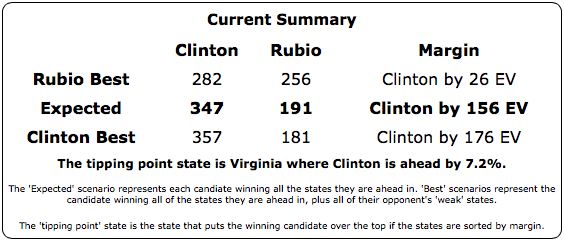
So, not winning against Clinton, just like all the other Republicans at the moment. But lets look at some comparisons with the other well polled Republicans. Since the Republicans are all losing right now, the “expected case” isn’t as interesting. Lets look instead at the Republican “best cases” and the tipping points:

First the “best cases”. Rubio is second only to Bush (amongst the five best polled combinations) at how close things look if you give him all the close states. Bush loses by 12 electoral votes, Rubio loses by 26. (Going down the line, Huckabee loses by 84, Paul by 108, and Christie by 156.) This is all in the best case of course, the case where the Republican holds all of the states they are ahead in and also flips all the states where Clinton is ahead by less than 5%. A less than 5% lead is a slim on that can go away pretty quickly, or be wiped out by polling error, so this is an important metric to look at.
But if we want to look at “how far does the candidate have to move the polls to win” that is what the tipping point is all about, so moving on to that:

All five of the candidates here end up in “Strong Clinton” territory at the moment. Rubio is again doing second best of these five Republicans against Clinton. Clinton leads Bush by 6.8%, Rubio by 7.2%, Paul by 7.6%, Christie by 8.0%, and Huckabee by 8.1%. Within this comparison, Rubio doesn’t do all that badly against the field. It’s just that none of them are doing all that great.
Of course, this is the time to remind everybody that even though an 8% lead sounds huge, it means that only 4% of the voting public… or 1 person out of 25, needs to change their mind in order to flip the election. (Or the undecideds have to break solidly in favor of the challenger, or turnout heavily favors the challenger, etc.) Now, the American electorate is very strongly polarized right now. But is it that hard to imagine 1 out of 25 people changing their minds if a big scandal hits Clinton and sticks? Or the economy goes south before the election? Nope. It isn’t. This far out, anything can still happen. Views like this show where things stand NOW, not where they will be in 556 days.
Note: This post is an update based on the data on my 2016 Electoral College Analysis Site. All of the charts and graphs seen here are from that site. Graphs, charts and raw data can be found there for the race nationally and in each state for every candidate combination that has been polled at the state level. In addition, comparisons of the best polled candidate combinations both nationally and each in each state are available. All charts above are clickable to go to the current version of the detail page the chart is from, which may contain more up to date information than the snapshots on this page, which were current as of the time of this post.
In the latest Curmudgeon’s Corner with Sam and IvГЎn:
* [0:00:10-0:07:43] Intro
* [0:07:59-0:24:59] Clinton
* [0:26:02-0:40:29] Rubio
* [0:43:00-1:03:58] Lightning Round

Recorded 2015-04-16
Length this week – 1:04:18
 1-Click Subscribe in iTunes 1-Click Subscribe in iTunes
 View Podcast in iTunes View Podcast in iTunes
 View Raw Podcast Feed View Raw Podcast Feed
 Download MP3 File Download MP3 File
 Follow the podcast on Facebook Follow the podcast on Facebook
|
|
































